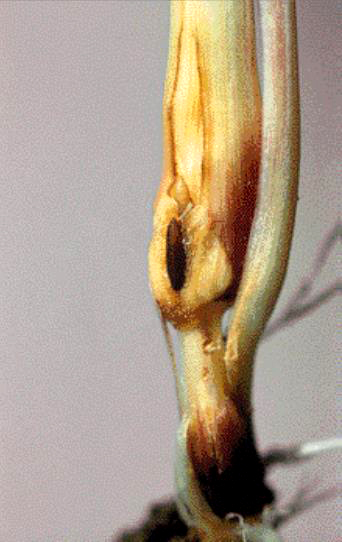Symptoms, description and lifecycle
Feeding damage on cereal plants can cause leaf discolouration, from a darker green to bluish green or slowing of new growth in seedlings. Plants are often stunted and tillers can become weakened causing plants to lodge. The main identifying feature of Barley stem gall midge is the formation of pea-sized galls (swellings of the plant tissue) at the base of host plant between the leaf sheath and stem.
Gall midge larvae have a long-lived larval stage specialised for feeding whereas adults are short lived and generally only last one to two days, during which time they do not feed but mate, find suitable host plants and lay eggs. Small numbers of eggs are laid indiscriminately on numerous host plants. Up to 400 eggs are laid per lifetime. Similar to Hessian fly larvae, they undergo three instars growing up to three to four mm in length. The second instar becomes a puparium within which the non-feeding third instar, pupa and adult develop. Larvae are initially pale red in colour and become milky white as they mature. Adults are small, mosquito like flies about two to four mm long, have one set of wings with a few weak veins and beaded, elongated antennae.
Organism
Mayetiola hordei
Host range
The preferred host of M. hordei is barley (Hordeum vulgare) but it will also feed on oat (Avena sativa), wheat (Triticum aestivum) and rye (Secale cereale). Stem galls are produced almost exclusively on barley but occasionally on oat, wheat and rye.
Method of spread
Adults spread by actively flying throughout the crop or using wind current. Long distance dispersal also occurs by ‘hitchhiking’ on machinery, clothes and plant material.
Confused with?
This species is very similar and closely related to the Hessian fly (Mayetiola destructor). Identification of the two species involves microscopic morphological differences and is best undertaken by an expert taxonomist.
Where?
Barley stem gall midge originated in Tunisia. Its range has expanded through North Africa and has been recorded in European countries; Spain, UK and France.

Image 24. The white larva and the dark brown pupa of the Barley stem gall midge. Source: ICARDA.


